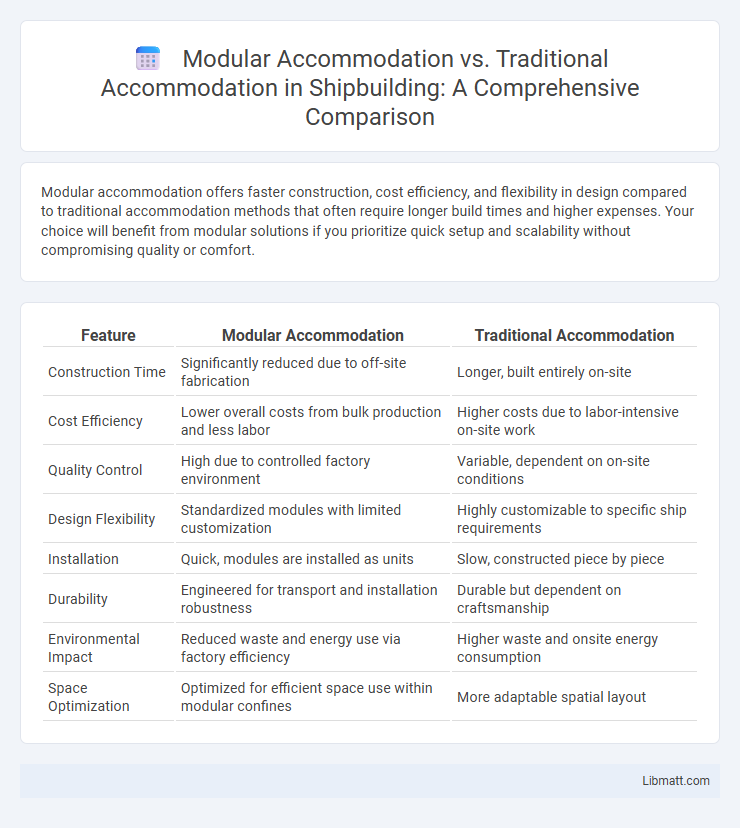Modular accommodation offers faster construction, cost efficiency, and flexibility in design compared to traditional accommodation methods that often require longer build times and higher expenses. Your choice will benefit from modular solutions if you prioritize quick setup and scalability without compromising quality or comfort.
Table of Comparison
| Feature | Modular Accommodation | Traditional Accommodation |
|---|---|---|
| Construction Time | Significantly reduced due to off-site fabrication | Longer, built entirely on-site |
| Cost Efficiency | Lower overall costs from bulk production and less labor | Higher costs due to labor-intensive on-site work |
| Quality Control | High due to controlled factory environment | Variable, dependent on on-site conditions |
| Design Flexibility | Standardized modules with limited customization | Highly customizable to specific ship requirements |
| Installation | Quick, modules are installed as units | Slow, constructed piece by piece |
| Durability | Engineered for transport and installation robustness | Durable but dependent on craftsmanship |
| Environmental Impact | Reduced waste and energy use via factory efficiency | Higher waste and onsite energy consumption |
| Space Optimization | Optimized for efficient space use within modular confines | More adaptable spatial layout |
Understanding Modular Accommodation
Modular accommodation utilizes prefabricated units constructed off-site and assembled quickly on location, offering flexibility and faster deployment compared to traditional accommodation methods reliant on on-site building processes. These structures often provide cost efficiency, reduced construction waste, and adaptability for changing needs, making them ideal for temporary or emergency housing solutions. Understanding modular accommodation helps you evaluate its benefits for scalable, sustainable, and time-sensitive lodging alternatives.
Defining Traditional Accommodation
Traditional accommodation refers to permanent, on-site structures constructed using conventional building materials such as brick, concrete, and wood. These accommodations typically involve longer construction times, higher labor costs, and fixed locations, making them less flexible for rapid deployment. Structural durability and custom architectural design often characterize traditional accommodations, catering primarily to long-term residential or commercial use.
Key Differences Between Modular and Traditional Methods
Modular accommodation involves prefabricated units constructed offsite and assembled onsite, enabling faster construction timelines and reduced labor costs compared to traditional methods where building occurs entirely onsite. Traditional accommodation allows for greater customization and structural complexity but often results in longer project durations and higher material waste. Sustainability also differs; modular construction typically generates less waste and has a smaller environmental footprint due to controlled manufacturing processes.
Speed of Construction and Deployment
Modular accommodation significantly accelerates construction and deployment, often reducing build times by up to 50% compared to traditional accommodation methods. Prefabricated modules are manufactured simultaneously off-site while site work progresses, enabling rapid assembly and immediate occupancy. This streamlined process minimizes disruption and allows for faster scaling in response to urgent housing or commercial needs.
Cost Efficiency and Budget Considerations
Modular accommodation significantly reduces construction costs by utilizing prefabricated components that minimize labor and material waste, resulting in faster project completion and lower overall expenses compared to traditional accommodation methods. Budget considerations favor modular solutions due to predictable pricing, reduced site disruption, and decreased contingency allowances, helping organizations adhere to strict financial plans. Traditional accommodation often incurs higher costs from prolonged construction timelines, on-site labor variability, and material price fluctuations, making modular options more cost-efficient for budget-conscious projects.
Sustainability and Environmental Impact
Modular accommodation significantly reduces environmental impact through minimized construction waste and lower energy consumption during manufacturing compared to traditional accommodation. The use of recyclable materials and efficient design in modular units enhances sustainability by enabling reuse and reducing carbon footprint. Traditional accommodation often involves more extensive resource extraction and site disruption, resulting in higher emissions and longer construction timelines.
Flexibility and Scalability of Design
Modular accommodation offers superior flexibility and scalability in design compared to traditional accommodation, allowing spaces to be easily reconfigured or expanded to meet evolving needs. Prefabricated components can be quickly assembled, relocated, or upgraded without major construction, providing adaptable solutions for temporary or long-term use. Your ability to customize and scale modular units ensures efficient use of space and resources, making them ideal for dynamic living or working environments.
Quality Control and Standardization
Modular accommodation offers superior quality control and standardization by utilizing factory-based construction processes, ensuring consistent materials and workmanship compared to traditional on-site builds. The controlled environment reduces exposure to weather delays and human error, resulting in higher precision and fewer defects. Your project benefits from predictable outcomes and uniform quality, enhancing safety and comfort across all units.
Maintenance and Longevity
Modular accommodation offers reduced maintenance costs due to factory-controlled construction, resulting in improved quality control and fewer on-site defects compared to traditional accommodation. The use of durable, prefabricated materials in modular units enhances longevity and weather resistance, often exceeding the lifespan of conventional buildings constructed with onsite methods. Traditional accommodation typically requires more frequent repairs and upkeep due to exposure to variable site conditions and inconsistent craftsmanship.
Ideal Use Cases for Modular vs Traditional Accommodation
Modular accommodation excels in scenarios requiring rapid deployment, such as disaster relief, temporary worker housing, or event venues, providing flexibility and scalability. Traditional accommodation is better suited for long-term residential or commercial projects where permanence, architectural customization, and integration with existing infrastructure are priorities. Your choice depends on whether you need speed and adaptability or durable, permanent structures designed for long-term use.
Modular accommodation vs traditional accommodation Infographic

 libmatt.com
libmatt.com